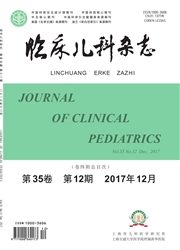

 中文摘要:
中文摘要:
目的:观察长期高氧暴露对新生小鼠肺微血管发育及Ephrin-B2表达的影响。方法2日龄昆明小鼠48只,随机分为高氧组和空气组,每组24只。高氧组采用吸入70%浓度氧气制作新生小鼠支气管肺发育不良(bronchopulmonary dysplasia,BPD)模型。于3、7、14、21日龄每组各处死6只小鼠。取肺组织,HE染色观察肺组织病理变化,行辐射状肺泡计数,CD34免疫组织化学染色观察微血管情况,并计数微血管数量。采用肺组织免疫组织化学染色检测Ephrin-B2表达定位及其光密度,同时采用实时荧光定量-聚合酶链反应技术和Western印迹技术检测Ephrin-B2 mRNA和蛋白表达水平。采用两独立样本t检验进行统计学分析。结果(1)肺组织病理及辐射状肺泡计数和微血管密度:随日龄增加,高氧组小鼠肺组织渐呈典型的BPD样改变,主要表现为肺泡发育简化,肺微血管数量减少。高氧组14日龄时辐射状肺泡计数和微血管密度均显著低于空气组[(6.067±0.432)与(6.950±0.243)个,t=4.365,P<0.05;4.133±0.476与4.867±0.472, t=2.680,P<0.01],21日龄时降低更加明显[(8.050±0.362)与(9.817±0.487)个,t=7.127,P<0.05;4.333±0.532与6.017±0.937,t=3.828,P<0.01]。(2)Ephrin-B2蛋白定位及表达强度:Ephrin-B2主要表达于肺泡上皮细胞,肺泡间隔亦有少许表达。高氧组7、14和21日龄Ephrin-B2表达强度(平均光密度)分别为0.146±0.013、0.140±0.007和0.138±0.008,均低于空气组(分别为0.153±0.009、0.161±0.006和0.166±0.009,t值分别为-2.049、-9.442和-10.087,P值均<0.05)。(3)Ephrin-B2 mRNA和蛋白含量:高氧组Ephrin-B2 mRNA在14和21日龄时明显低于空气组(0.65±0.14与1.05±0.16,0.57±0.09与1.13±0.18,t值分别为4.609和6.816,P值均<0.01);高氧组Ephrin-B2蛋白含量(相对灰度值)在21日龄时低于空气组(0.13±0.03与0.29±0.08,t=4.587,P<
 英文摘要:
英文摘要:
ObjectiveTo investigate the effects of long-term oxygen exposure on the pulmonary microvascular development and the expression of Ephrin-B2 of lungt issue in neonatal mice.MethodsForty-eight 2-day-old Kunming mice were randomly divided into hyperoxia group and air group, with 24 mice in each group. Mice in hyperoxia group were exposed to 70% oxygen to establish a model of bronchopulmonary dysplasia (BPD). Six mice from each group were sacrificed at 3, 7, 14 and 21 days of age, and lung tissue was collected for further test. The lung sections were stained with hematoxylin and eosin for histological evaluation, radial alveolar counts (RAC) and microvessel density (MVD) measurement by CD34 immunohistochemistry. Location and expression of Ephrin-B2 in lung tissue were measured by immunohistochemistry. Ephrin-B2 mRNA and protein levels were detected by fluorescent quantitative reverse transcriptase-polymerase chain reaction and Western blot, respectively. Two independent samplest-test was used for statistical analysis. Results(1) Pathological changes: The pathology of lung tissue in hyperoxia group showed typical BPD-like changes with advancing postnatal age, presenting mainly with simplified alveolar development and decreased microvessel number. Compared with the air group, RAC and MVD were significantly decreased in 14-day-old mice (6.067±0.432 vs 6.950±0.243,t=4.365,P〈0.05; 4.133±0.476 vs 4.867±0.472,t=2.680,P〈0.01) and 21-day-old mice in the hyperoxia group (8.050±0.362 vs 9.817±0.487,t=7.127,P〈0.05; 4.333±0.532 vs 6.017±0.937,t=3.828,P〈0.01). (2) Location and expression of Ephrin-B2: Ephrin-B2 was mainly expressed in alveolar epithelial cells, and weakly expressed in alveolar septum. Compared with the air group, the average optical density of Ephrin-B2 was significantly decreased in 7-day-old (0.146±0.013 vs 0.153±0.009), 14-day-old (0.140±0.007 vs 0.161±0.006) and 21-day-old mice in the hyperoxia group (0.138±0.008 vs 0.166±0.009)(t=-
 同期刊论文项目
同期刊论文项目
 同项目期刊论文
同项目期刊论文
 期刊信息
期刊信息
